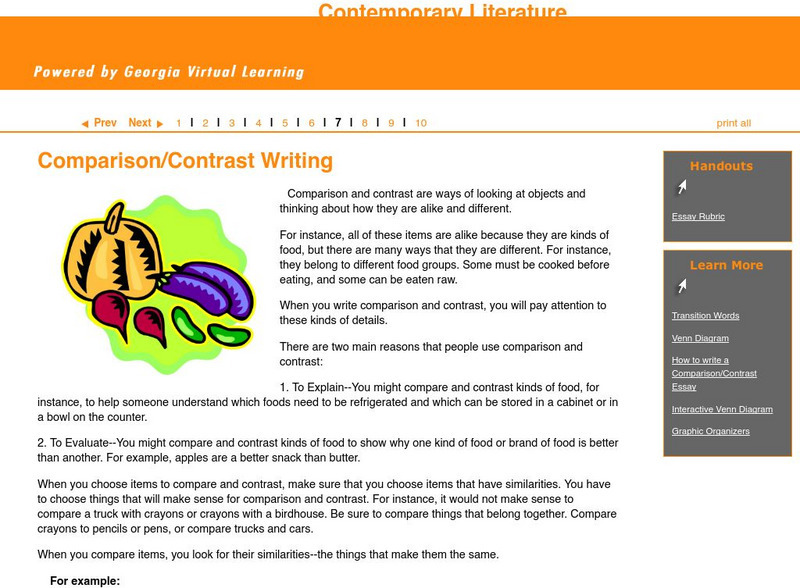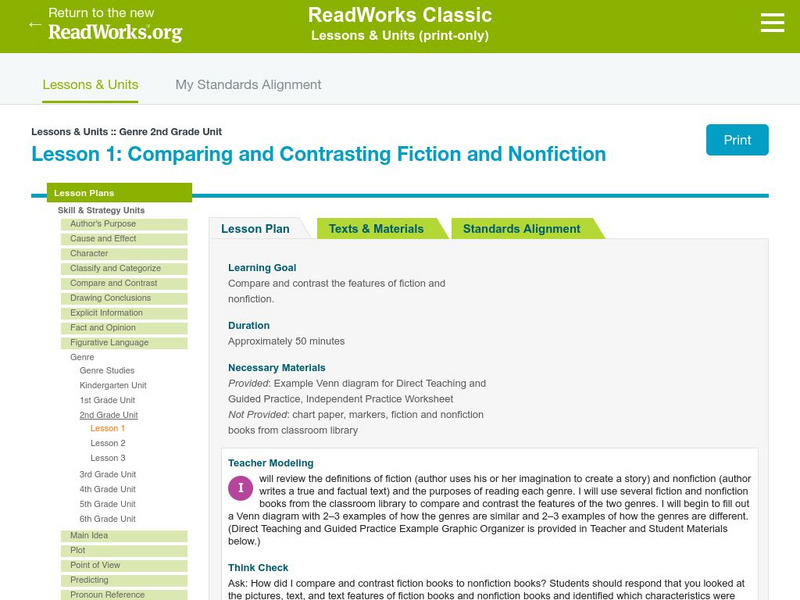Hi, what do you want to do?
New York State Education Department
TASC Transition Curriculum: Workshop 5
Are video games sports? Pupils investigate this question as well as various nonfiction selections to learn more about claims and the support that defines them. All of the selections mimic the rigor on state tests and encourage close...
ReadWriteThink
Read Write Think: Comparing Fiction and Nonfiction With Little Red Riding Hood
Contains plans for nine 50-minute lessons that center around different versions of "Little Red Riding Hood." In addition to objectives and standards, this instructional plan contains links to PDF handouts and sites used in the lessons as...
ReadWriteThink
Read Write Think: Animal Study From Fiction to Facts
Contains plans for five 50-minute lessons that ask young scholars to compare and research information about animals from fiction and nonfiction texts. In addition to student objectives and standards, these instructional plans contains...
Georgia Department of Education
Ga Virtual Learning: Contemporary Nonfiction: Comparison/contrast Writing
This lesson focuses on how to write a nonfiction comparison/contrast paper including the reasons for writing them and the three organizational strategies. It features links to transition words, graphic organizers, Venn diagrams,...
Tom Richey
Slide Share: Author's Purpose and Point of View
This downloadable slideshow focuses on how an author's purpose and point of view work together in fiction and nonfiction, and how to identify the point of view.
Polk Brothers Foundation Center for Urban Education at DePaul University
Depaul University: Center for Urban Education: I Can Compare and Contrast [Pdf]
This resource is a poster that includes cues that will help students compare and contrast information. These questions can be applied to fiction and nonfiction passages.
British Library
British Library: 19th Century Non Fiction Texts: Work & Welfare
This thematic collection will allow students to read and understand 19th-century non-fiction texts, and support them in identifying key features for a range of genres, audiences, and purposes. Each source is accompanied by original...
British Library
British Library: 19th Century Non Fiction Texts: Gender, Behaviour & Etiquette
This thematic collection will allow young scholars to read and understand 19th-century non-fiction texts, and support them in identifying key features for a range of genres, audiences, and purposes. Each source is accompanied by original...
Read Works
Read Works: 2nd Grade Lesson: Compare/contrast Genres
[Free Registration/Login Required] A lesson in which students use fiction and nonfiction books from a classroom library to identify the similarities and differences between fiction and nonfiction and to create a Venn diagram...
Polk Brothers Foundation Center for Urban Education at DePaul University
Depaul University: Center for Urban Education: Compare and Contrast [Pdf]
This Center for Urban Education resource provides a downloadable graphic organizer designed for comparing and contrasting fiction or nonfiction characteristics.
Education.com
Education.com: Compare and Contrast Non Fiction Stories: Extinct Birds
[Free Registration/Login Required] Students will compare two informational texts about two extinct birds, the Great Auk and the Dodo. A Venn Diagram is provided to be used when comparing an contrasting tests.
Read Works
Read Works: Compare and Contrast 3rd Grade Unit
[Free Registration/Login Required] A three-lesson unit on comparing and contrasting through which students learn how to compare two items using key terms, compare and contrast two non-fiction texts on similar topics, and compare and...
ReadWriteThink
Read Write Think: Text Features: Non Fiction [Pdf]
Compare the printed page to an electronic web page and use this activity to discuss the similarities and differences. A cross-curricular tie-in with ecosystems. Could easily be adapted to another subject area.
TES Global
Tes: Analyzing & Comparing Non Fiction
[Free Registration/Login Required] Resource notes to aid young scholars as they analyze different types of nonfiction. The GAP (genre, audience, and purpose) acronym is provided to use when comparing nonfiction texts.
National Endowment for the Humanities
Neh: Edsit Ement: Steinbeck's Use of Nonfiction Sources in "The Grapes of Wrath"
In this lesson plan, students will consider Steinbeck's Use of Nonfiction Sources in "The Grapes of Wrath". Worksheets and other supporting materials can be found under the Resources tab. In this lesson students will compare nonfiction...
Louisiana Department of Education
Louisiana Doe: Louisiana Believes: English Language Arts: Grade 7: Excerpts From Behind the Scenes
Seventh graders explore a tumultuous period in our country's history during which people questioned political decisions, morals, and social norms. This unit presents opportunities for students to examine different perspectives through...
Read Works
Read Works: Snowflake Bentley
[Free Registration/Login Required] In this ReadWorks read aloud lesson, students will describe Bentley's environment and his interactions with it. Students will evaluate the impact a person's environment can have on life. Then students...
Utah Education Network
Uen: One True Story, Told Two Ways
Analyze the different perspectives presented by two authors telling the same story.
Read Works
Read Works: Grade 2: Two Lesson Unit: Explicit Information
[Free Registration/Login Required] Designed to teach students to identify explicit information in nonfiction and fiction texts. Lessons are based on the books Deserts (A True Book-Ecosystems) by Darlene R. Stille and The Stories Huey...










![Depaul University: Center for Urban Education: I Can Compare and Contrast [Pdf] Graphic Depaul University: Center for Urban Education: I Can Compare and Contrast [Pdf] Graphic](https://static.lp.lexp.cloud/images/attachment_defaults/resource/large/FPO-knovation.png)






